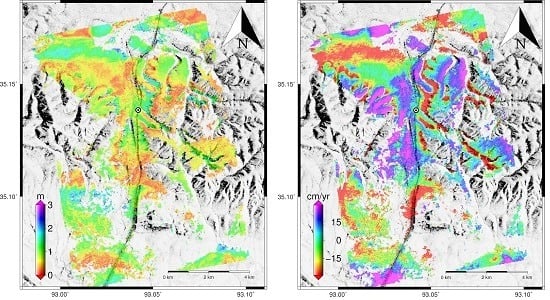Characterization of Active Layer Thickening Rate over the Northern Qinghai-Tibetan Plateau Permafrost Region Using ALOS Interferometric Synthetic Aperture Radar Data, 2007–2009
Abstract
:1. Introduction
2. Study Region and Data
3. Data Processing and Methodology
3.1. InSAR Processing
3.2. Models of InSAR Observations and Time Series of Surface Deformation
3.3. Converting Surface Displacement to ALT Changes
4. Results
5. Discussion
5.1. Causes of SBAS-InSAR Observed Displacement
5.2. Spatial Variability of ALT/ALT Change
5.3. Advantages and Limitations of the InSAR-Based Methodology
6. Conclusions
Acknowledgments
Author Contributions
Conflicts of Interest
References
- Woo, M. Permafrost Hydrology; Springer: Berlin/Heidelberg, Germany, 2012. [Google Scholar]
- Zhang, T.; Barry, R.G.; Knowles, K.; Heginbottom, J.A.; Brown, J. Statistics and characteristics of permafrost and ground-ice distribution in the Northern Hemisphere. Polar Geogr. 2008, 31, 47–68. [Google Scholar] [CrossRef]
- Pang, Q.Q.; Cheng, Q.D.; Li, S.X.; Zhang, W.G. Active layer thickness calculation over the Qinghai-Tibet Plateau. Cold Reg. Sci. Technol. 2009, 57, 23–28. [Google Scholar] [CrossRef]
- IPCC (Intergovernmental Panel on Climate Change). Climate Change 2007: The Physical Science Basis, Summary for Policymakers; Cambridge University Press: Cambridge, UK; New York, NY, USA, 2007. [Google Scholar]
- Lemke, P.; Ren, J.; Alley, R.; Allison, I.; Carrasco, J.; Flato, G.; Fujii, Y.; Kaser, G.; Mote, P.; Thomas, R.; et al. Observations: Changes in Snow, Ice and Frozen Ground; IPCC WG1 Fourth Assessment Report; Cambridge University Press: Cambridge, UK; New York, NY, USA, 2007; Chapter 4. [Google Scholar]
- Osterkamp, T.E. A thermal history of permafrost in Alaska. In Proceedings of the 8th International Conference on Permafrost, Zurich, Switzerland, 21–25 July 2003; Phillips, M., Springman, S.M., Arenson, L.U., Eds.; A.A. Balkema: Lisse, The Netherlands, 2003; pp. 863–867. [Google Scholar]
- Osterkamp, T.E. Characteristics of the recent warming of permafrost in Alaska. J. Geophys. Res. 2007, 112, F02S02. [Google Scholar] [CrossRef]
- Oberman, N.G.; Mazhitova, G.G. Permafrost dynamics in the northeast of European Russia at the end of the 20th century. Norw. J. Geogr. 2001, 55, 241–244. [Google Scholar]
- Wu, Q.; Zhang, T. Recent permafrost warming on the Qinghai-Tibetan Plateau. J. Geophys. Res. 2008, 113, D13108. [Google Scholar] [CrossRef]
- Wu, Q.; Zhang, T. Changes in active layer thickness over the Qinghai-Tibetan Plateau from 1995 to 2007. J. Geophys. Res. 2010, 115, D09107. [Google Scholar] [CrossRef]
- Wu, Q.; Zhang, T.; Liu, Y. Thermal state of the active layer and permafrost along the Qinghai-Xizang (Tibet) Railway from 2006 to 2010. Cryosphere 2012, 6, 607–612. [Google Scholar] [CrossRef] [Green Version]
- Wang, B.L.; French, H.M. Permafrost on the Tibet Plateau, China. Q. Sci. Rev. 1995, 14, 255–274. [Google Scholar] [CrossRef]
- Qiu, J. The third pole. Nature 2008, 454, 393–395. [Google Scholar] [CrossRef] [PubMed]
- Brown, J.; Hinkel, K.M.; Nelson, F.E. The circumpolar active layer monitoring (CALM) program: Research designs and initial results. Polar Geogr. 2000, 24, 166–258. [Google Scholar] [CrossRef]
- Mackay, J. A frost tube for the determination of freezing in the active layer above permafrost. Can. Geotech. J. 1973, 10, 392–396. [Google Scholar] [CrossRef]
- Nixon, F.; Taylor, A. Regional active layer monitoring across the sporadic, discontinuous and continuous permafrost zones, Mackenzie Valley, northwestern Canada. In Proceedings of the Seventh International Conference on Permafrost, Yellowknife, NT, Canada, 23–27 June 1998; pp. 815–820.
- Rickard, W.; Brown, J. Performance of a frost-tube for determination of soil freezing and thawing depths. Soil Sci. 1972, 113, 149–154. [Google Scholar] [CrossRef]
- Oelke, C.; Zhang, T.J. Modeling the active-layer depth over the Tibetan Plateau. Arct. Antarct. Alp. Res. 2007, 39, 714–722. [Google Scholar] [CrossRef]
- Liu, L.; Schaefer, K.; Zhang, T.; Estimating, J.W. 1992–2000 average active layer thickness on the Alaskan North Slope from remotely sensed surface subsidence. J. Geophys. Res. 2012, 117, F01005. [Google Scholar] [CrossRef]
- Liu, L.; Zhang, T.; Wahr, J. InSAR measurements of surface deformation over permafrost on the North Slope of Alaska. J. Geophys. Res. 2010, 115, F03023. [Google Scholar] [CrossRef]
- Schaefer, K.; Liu, L.; Parsekian, A.; Jafarov, E.; Chen, A.; Zhang, T.; Gusmeroli, A.; Panda, S.; Zebker, H.A.; Schaefer, T. Remotely sensed active layer thickness (ReSALT) at Barrow, Alaska using interferometric synthetic aperture radar. Remote Sens. 2015, 7, 3735–3759. [Google Scholar] [CrossRef]
- Brügmann, R.; Rosen, P.A.; Fielding, E.J. Synthetic aperture radar interferometry to measure Earth’s surface topography and its deformation. Annu. Rev. Earth Planet. Sci. 2000, 28, 169–209. [Google Scholar] [CrossRef]
- Jia, Y.Y.; Shum, C.; Kim, J.W.; Su, X.; Kuo, C. Study of the northern Qinghai-Tibetan plateau permafrost active layer depth rate using satellite geodetic observations. In Proceedings of the 2015 AGU Fall Meeting, San Francisco, CA, USA, 14–18 December 2015.
- Kim, J.; Shum, C.; Erkan, K.; Lee, H.; Lu, Z. InSAR imaging of Tibetan plateau discontinuous permafrost. In Proceedings of the IUGG General Assembly 2011, Earth on the Edge: Science for a Sustainable Planet, Melbourne, Australia, 28 June–7 July 2011.
- Li, Z.W.; Zhao, R.; Hu, J.; Wen, L.X.; Feng, G.C.; Zhang, Z.Y.; Wang, Q.J. InSAR analysis of surface deformation over permafrost to estimate active layer thickness based on one-dimensional heat transfer model of soils. Nat. Sci. Rep. 2015, 5, 15542. [Google Scholar] [CrossRef] [PubMed]
- Hanssen, R.F. Radar Interferometry: Data Interpretation and Error Analysis; Kluwer Academic Publishers: Dordrecht, The Netherlands, 2001. [Google Scholar]
- Goldstein, R.M.; Werner, C.L. Radar interferogram filtering for geophysical applications. Geophys. Res. Lett. 1998, 25, 4035–4038. [Google Scholar] [CrossRef]
- Costantini, M. A novel phase unwrapping method based on network programming. IEEE Trans. Geosci. Remote Sens. 1998, 36, 813–821. [Google Scholar] [CrossRef]
- Berardino, P. A new algorithm for surface deformation monitoring based on small baseline differential SAR interferograms. IEEE Trans. Geosci. Remote Sens. 2002, 40, 11. [Google Scholar] [CrossRef]
- Erkan, K.; Shum, C.; Wang, L.; Guo, J.; Jekeli, C.; Lee, H.; Panero, W.; Duan, J.; Huang, Z.; Wang, H. Geodetic constraints on the Qinghai-Tibetan Plateau present-day geophysical processes. Terr. Atmos. Ocean. Sci. 2011, 22, 241–253. [Google Scholar] [CrossRef]
- Tong, C.J.; Wu, Q.B. The effect of climate warming on the Qinghai-Tibet Highway, Cold Reg. Sci. Technol. 1996, 24, 101–106. [Google Scholar]
- Wu, Q.B.; Liu, Y.Z.; Zhang, J.M.; Tong, C.J. A review of recent frozen soil engineering in permafrost regions along Qinghai-Tibet Highway, China. Permafr. Periglac. 2002, 13, 199–205. [Google Scholar]
- Wessel, P.; Smith, W.H.F. New, improved version of the Generic Mapping Tools released. EOS Trans. Am. Geophys. Union 1998, 79, 579. [Google Scholar] [CrossRef]
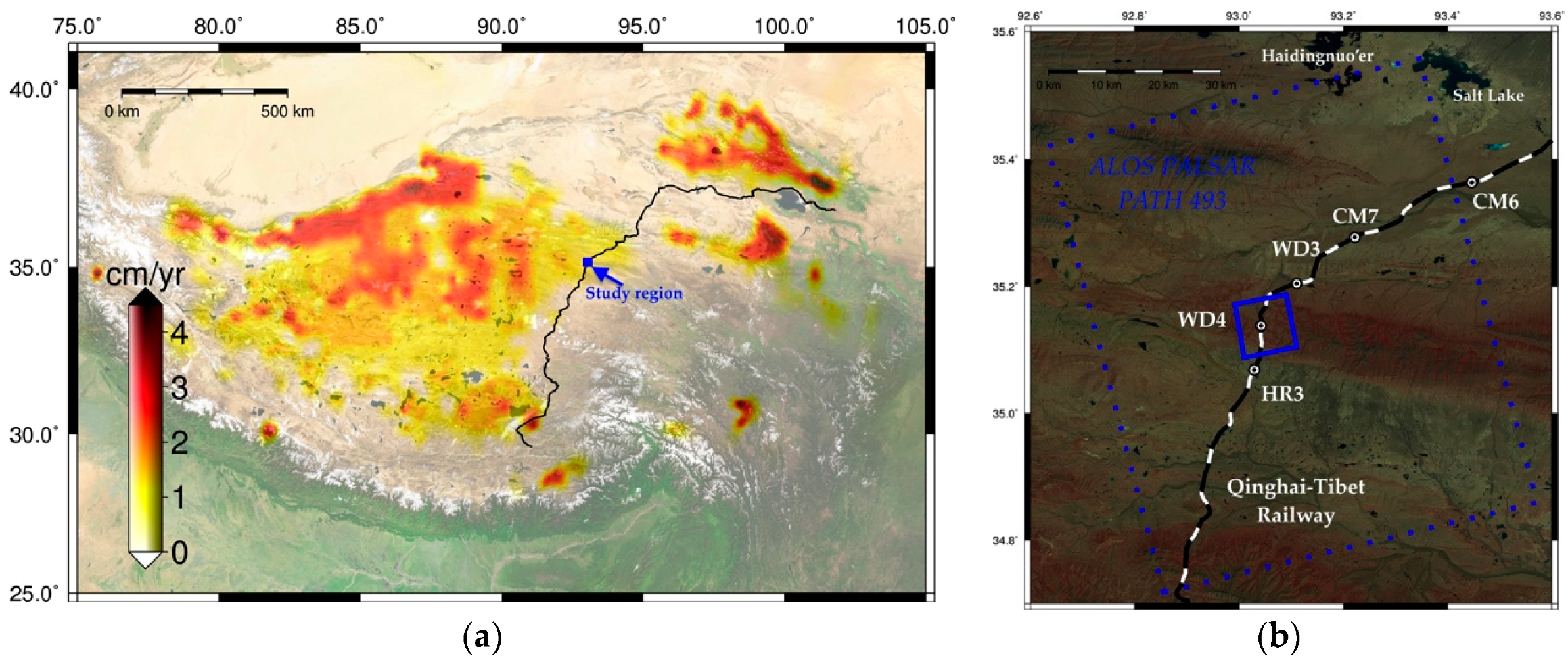
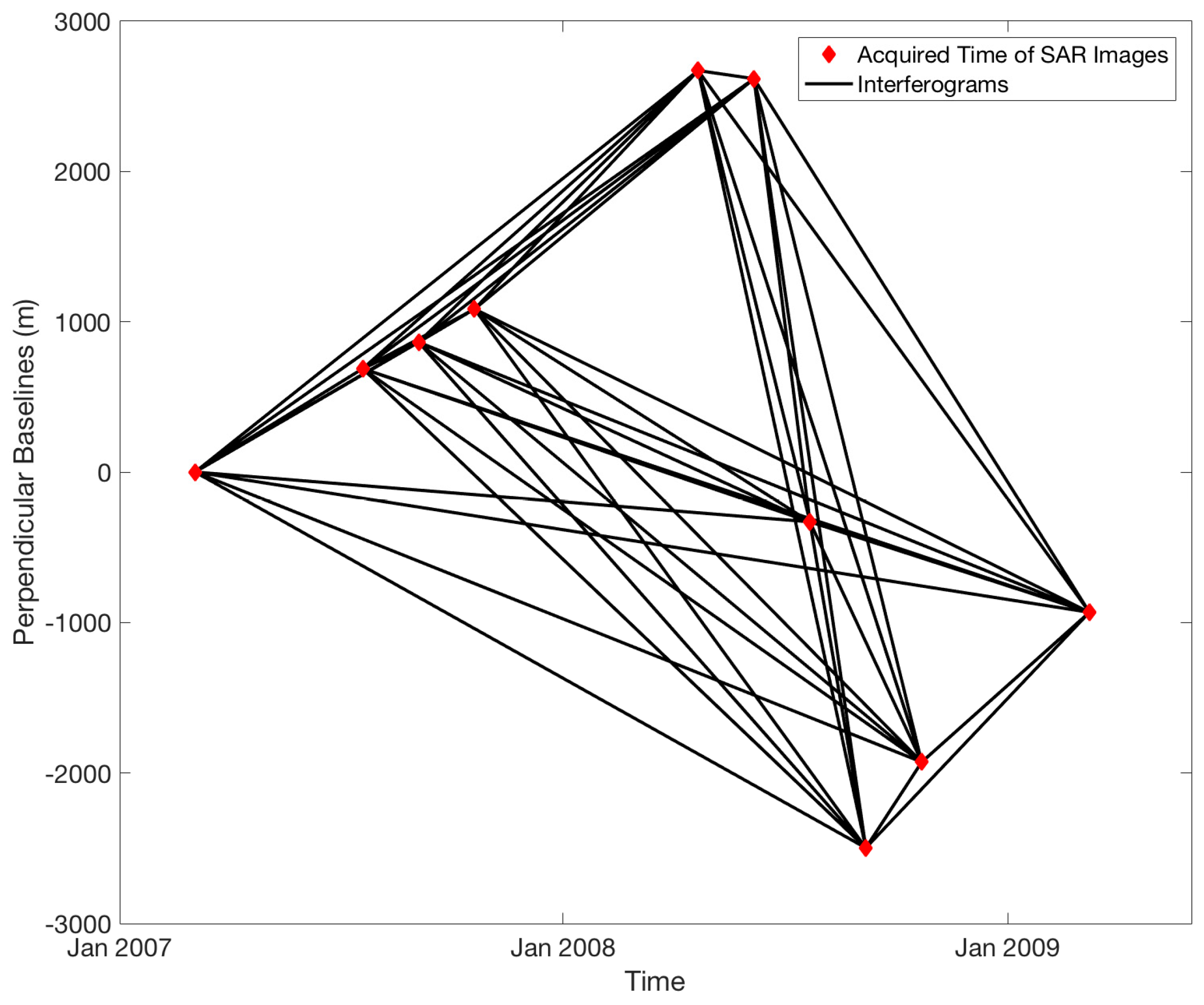

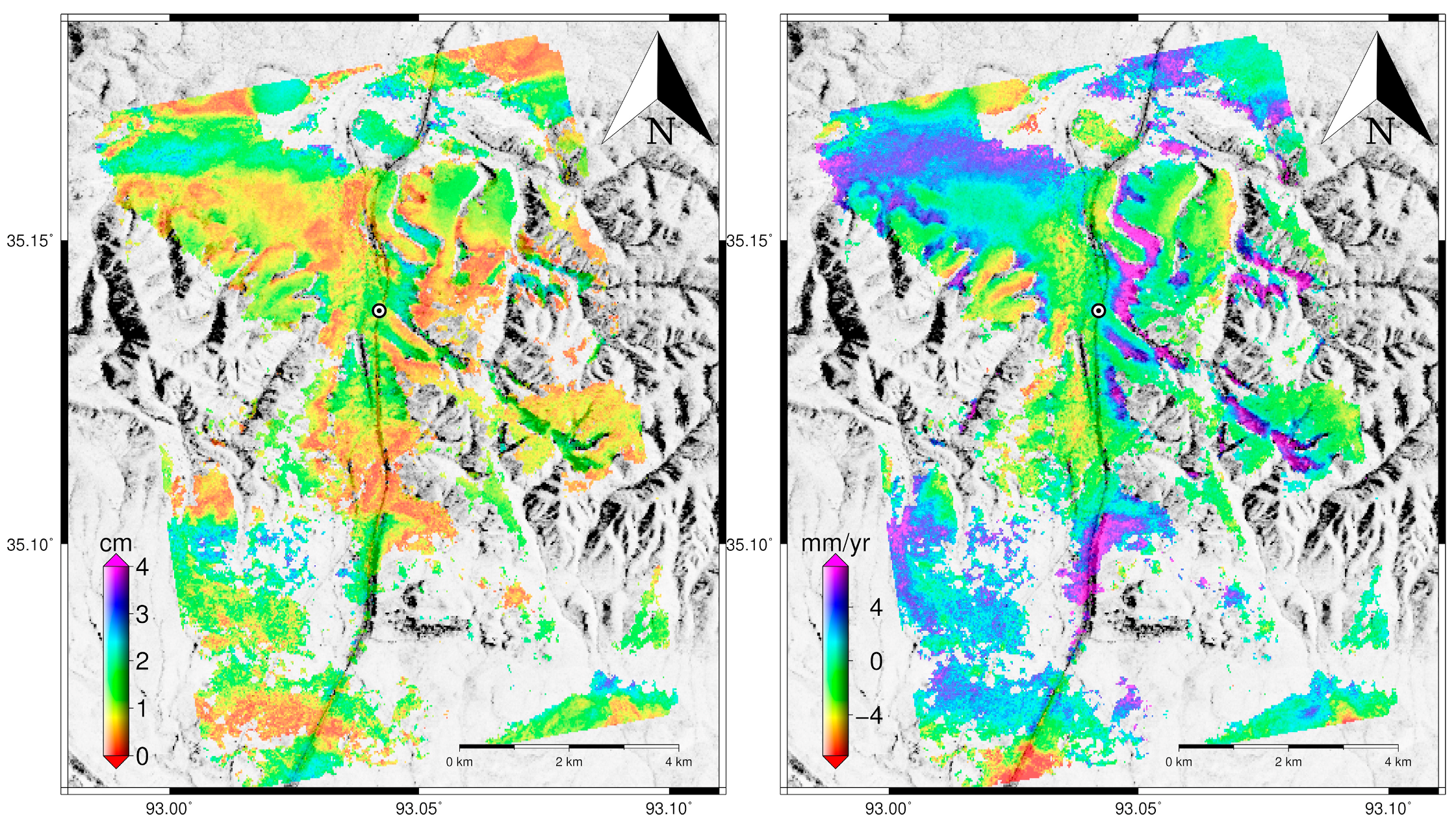
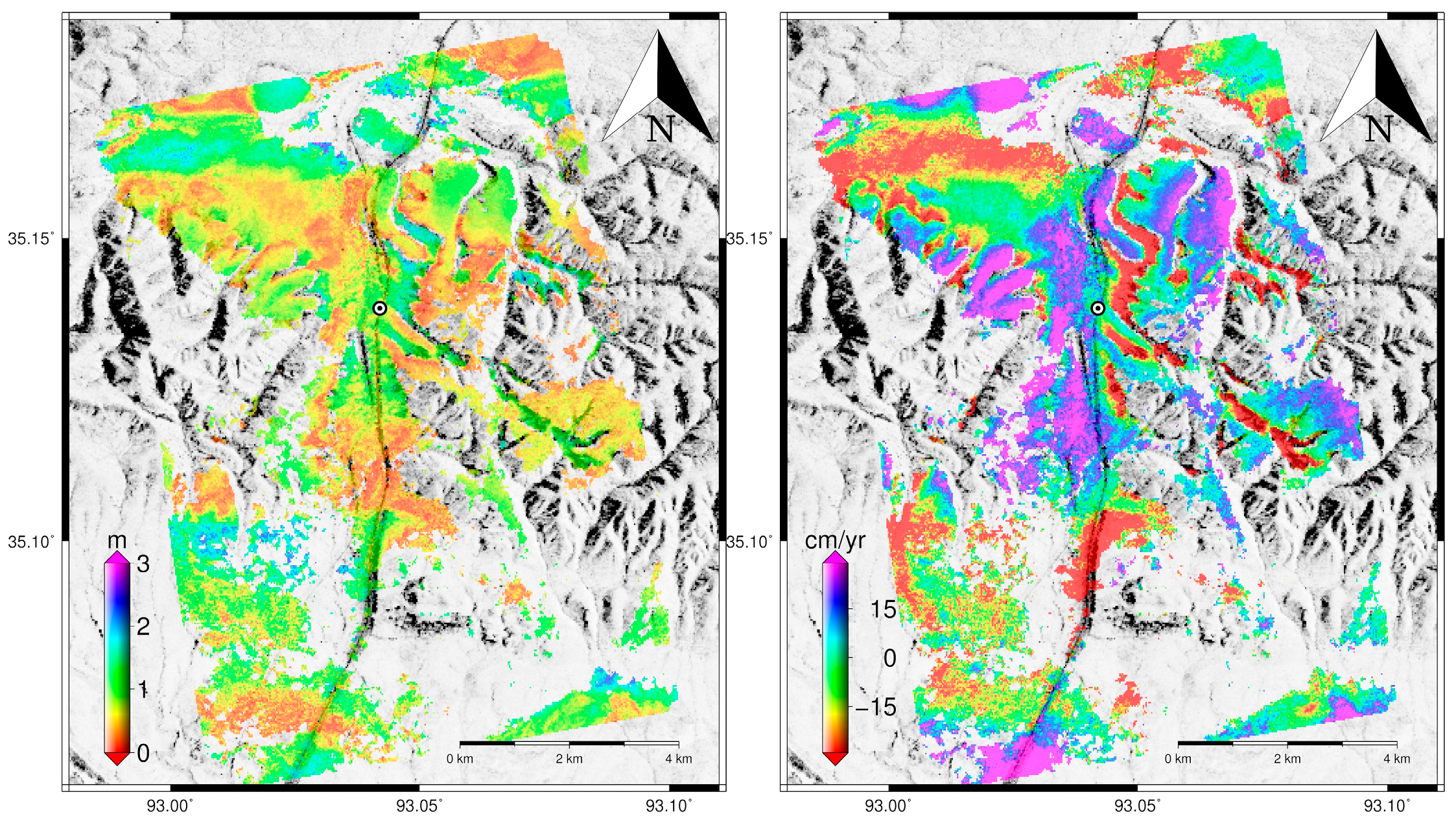
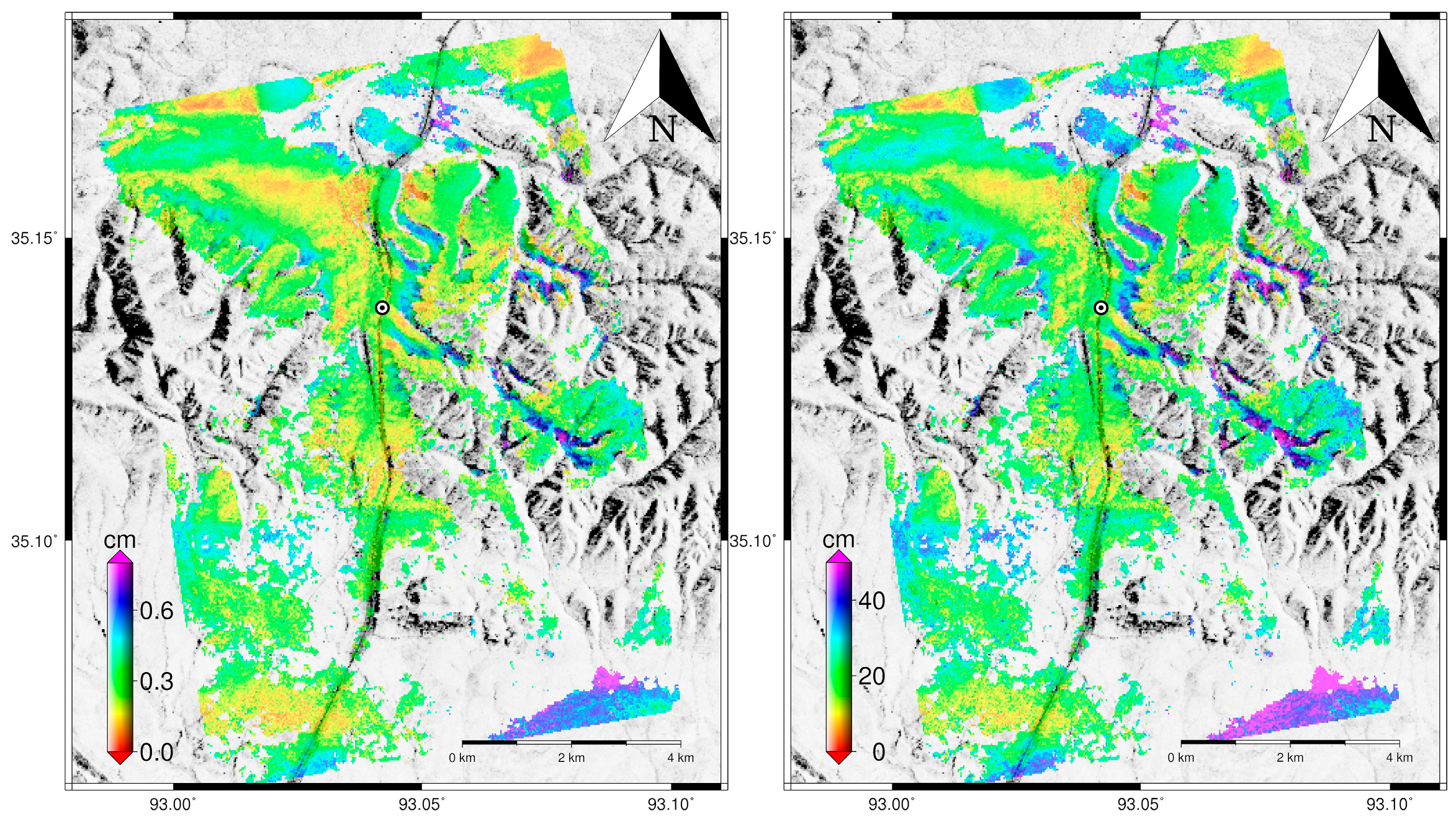
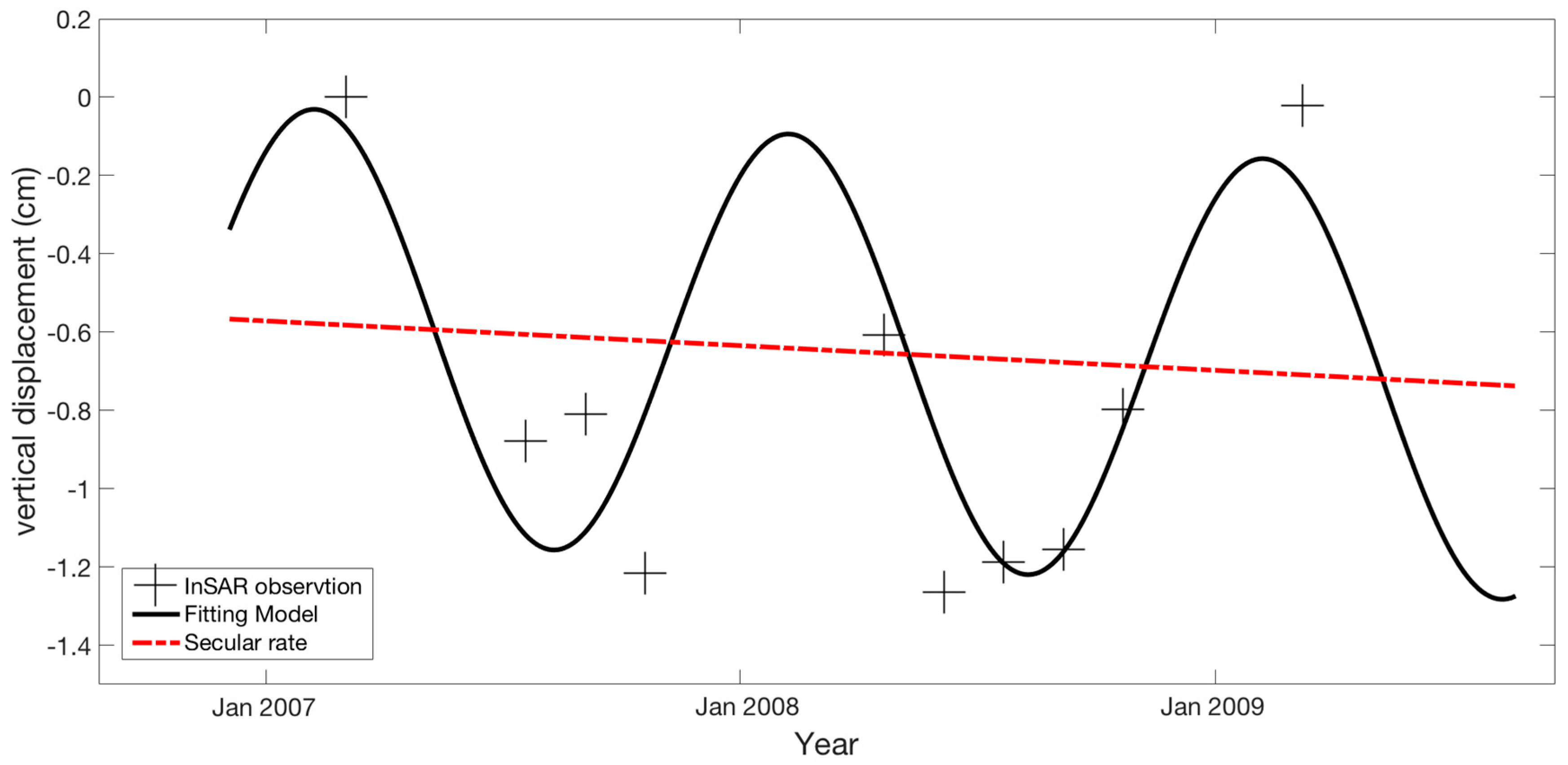
| Date | Sensor | Path | Beam | Band | Direction | Incidence Angle (°) |
|---|---|---|---|---|---|---|
| 4 March 2007 | PALSAR | 493 | Fine | L-band | Ascending | 38.7245 |
| 20 July 2007 | PALSAR | 493 | Fine | L-band | Ascending | 38.7306 |
| 4 September 2007 | PALSAR | 493 | Fine | L-band | Ascending | 38.7270 |
| 20 October 2007 | PALSAR | 493 | Fine | L-band | Ascending | 38.7307 |
| 21 April 2008 | PALSAR | 493 | Fine | L-band | Ascending | 38.7239 |
| 6 June 2008 | PALSAR | 493 | Fine | L-band | Ascending | 38.7278 |
| 22 July 2008 | PALSAR | 493 | Fine | L-band | Ascending | 38.7335 |
| 6 September 2008 | PALSAR | 493 | Fine | L-band | Ascending | 38.7323 |
| 22 October 2008 | PALSAR | 493 | Fine | L-band | Ascending | 38.7374 |
| 9 March 2009 | PALSAR | 493 | Fine | L-band | Ascending | 38.7414 |
© 2017 by the authors; licensee MDPI, Basel, Switzerland. This article is an open access article distributed under the terms and conditions of the Creative Commons Attribution (CC-BY) license (http://creativecommons.org/licenses/by/4.0/).
Share and Cite
Jia, Y.; Kim, J.-W.; Shum, C.K.; Lu, Z.; Ding, X.; Zhang, L.; Erkan, K.; Kuo, C.-Y.; Shang, K.; Tseng, K.-H.; et al. Characterization of Active Layer Thickening Rate over the Northern Qinghai-Tibetan Plateau Permafrost Region Using ALOS Interferometric Synthetic Aperture Radar Data, 2007–2009. Remote Sens. 2017, 9, 84. https://doi.org/10.3390/rs9010084
Jia Y, Kim J-W, Shum CK, Lu Z, Ding X, Zhang L, Erkan K, Kuo C-Y, Shang K, Tseng K-H, et al. Characterization of Active Layer Thickening Rate over the Northern Qinghai-Tibetan Plateau Permafrost Region Using ALOS Interferometric Synthetic Aperture Radar Data, 2007–2009. Remote Sensing. 2017; 9(1):84. https://doi.org/10.3390/rs9010084
Chicago/Turabian StyleJia, Yuanyuan, Jin-Woo Kim, C. K. Shum, Zhong Lu, Xiaoli Ding, Lei Zhang, Kamil Erkan, Chung-Yen Kuo, Kun Shang, Kuo-Hsin Tseng, and et al. 2017. "Characterization of Active Layer Thickening Rate over the Northern Qinghai-Tibetan Plateau Permafrost Region Using ALOS Interferometric Synthetic Aperture Radar Data, 2007–2009" Remote Sensing 9, no. 1: 84. https://doi.org/10.3390/rs9010084





